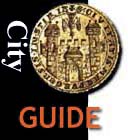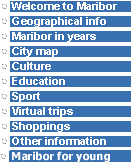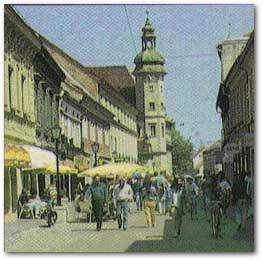

![]()
 Throughout the centuries, the population of
Maribor has changed considerably. People came to Maribor
from the different countries of Central Europe, as well
as Hungary and Italy, and merged with the local
residents.
Throughout the centuries, the population of
Maribor has changed considerably. People came to Maribor
from the different countries of Central Europe, as well
as Hungary and Italy, and merged with the local
residents.
![]() In the Middle Ages the people of Slovene and
German descent lived here; the Jewish community was also
quite large. Following a number of natural disasters,
fires and epidemics at the end of the seventeenth century
the population severely decreased. The town then
attracted mostly country people from the Podravje region.
It also started to draw people from other Slovene
regions. At this time the German population began to
emerge as a power in Maribor, mainly by occupying many
civil service positions and contributing heavily to the
armed forces. The power of the German community grew in
proportion to its economic growth. The local Slovenes
were mainly dependent upon the Germans for their
livelihood. This economic dependency made them easy prey
to Germanization.
In the Middle Ages the people of Slovene and
German descent lived here; the Jewish community was also
quite large. Following a number of natural disasters,
fires and epidemics at the end of the seventeenth century
the population severely decreased. The town then
attracted mostly country people from the Podravje region.
It also started to draw people from other Slovene
regions. At this time the German population began to
emerge as a power in Maribor, mainly by occupying many
civil service positions and contributing heavily to the
armed forces. The power of the German community grew in
proportion to its economic growth. The local Slovenes
were mainly dependent upon the Germans for their
livelihood. This economic dependency made them easy prey
to Germanization.
![]() With an awakening of nationalism in
the middle of the nineteenth century, the native Slovenes
were determined to assert themselves in Maribor, even
more so in the overwhelmingly Slovene countryside.
With an awakening of nationalism in
the middle of the nineteenth century, the native Slovenes
were determined to assert themselves in Maribor, even
more so in the overwhelmingly Slovene countryside.
![]() After World War I, the German civil service
component, as well as their soldiers, left Maribor
however, German owners of businesses, tradesmen and
merchants remained. The city then took in several
thousand Slovene exiles from the Littoral, which was
occupied by the Italians. Maribor thus gained a
cosmopolitan Slovene image.
After World War I, the German civil service
component, as well as their soldiers, left Maribor
however, German owners of businesses, tradesmen and
merchants remained. The city then took in several
thousand Slovene exiles from the Littoral, which was
occupied by the Italians. Maribor thus gained a
cosmopolitan Slovene image.
![]() After World War II, most of the residents of
German nationality left Maribor. Local residents who had
been exiled to Serbia, Croatia, or the Reich returned.
Industrial development has drawn to a Maribor almost in
ruins because of the war a large capable work-force; new
residents flocked to Maribor mostly from the broad
hinterlands of the Pomurje region, the Slovenske gorice
hills, the Haloze hills the Dravsko polje (Drava Field)
and the Dravska dolina (Drava Valley), as well as from
other parts of Slovenia. Many new inhabitants also came
from western Croatia, as well as other regions of
Yugoslavia.
After World War II, most of the residents of
German nationality left Maribor. Local residents who had
been exiled to Serbia, Croatia, or the Reich returned.
Industrial development has drawn to a Maribor almost in
ruins because of the war a large capable work-force; new
residents flocked to Maribor mostly from the broad
hinterlands of the Pomurje region, the Slovenske gorice
hills, the Haloze hills the Dravsko polje (Drava Field)
and the Dravska dolina (Drava Valley), as well as from
other parts of Slovenia. Many new inhabitants also came
from western Croatia, as well as other regions of
Yugoslavia.
![]() The Maribor accent may appear to those
from other parts of Slovenia to be rather original; it
may also well occasion a smirk, if not a burst of
laughter. What, then, is so unique about it? Maribor is a
junction of three regions and thus of three dialects the
Kozjak, the Slovenske gorice hills, and the Pohorje.
Elements of all three intermix: long, tense vowels
diphthongization, the so-called "akanje" (that
is, turning a semivowel into an "ah" sound),
and falling intonation. These are most characteristic of
the suburban Maribor accents. The Maribor town, or city
accent, tends toward a monophthong system. It used to be
heavily interlaced with German loanwords, corrupt
borrowings, and foreign syntactical constructions. These
linguistic elements have by now greatly diminished, since
new generations have been taught to approximate the
Maribor variant of colloquial Slovene language. However,
it is noticeable, that particularly among the youth of
school age, a well differentiated slang is becoming
popular, with borrowings from Serbo-Croatian and English,
predominating.
The Maribor accent may appear to those
from other parts of Slovenia to be rather original; it
may also well occasion a smirk, if not a burst of
laughter. What, then, is so unique about it? Maribor is a
junction of three regions and thus of three dialects the
Kozjak, the Slovenske gorice hills, and the Pohorje.
Elements of all three intermix: long, tense vowels
diphthongization, the so-called "akanje" (that
is, turning a semivowel into an "ah" sound),
and falling intonation. These are most characteristic of
the suburban Maribor accents. The Maribor town, or city
accent, tends toward a monophthong system. It used to be
heavily interlaced with German loanwords, corrupt
borrowings, and foreign syntactical constructions. These
linguistic elements have by now greatly diminished, since
new generations have been taught to approximate the
Maribor variant of colloquial Slovene language. However,
it is noticeable, that particularly among the youth of
school age, a well differentiated slang is becoming
popular, with borrowings from Serbo-Croatian and English,
predominating.